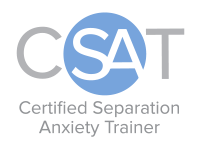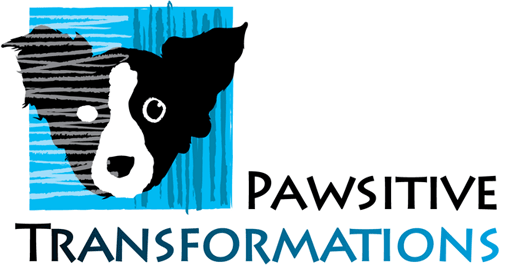
What is Separation Anxiety?
Separation anxiety (SA) is a panic attack that affects dogs who are scared to be alone. It’s a phobia – much like a fear of heights, snakes, or spiders in humans. Like any version of fear or anxiety, a dog has no control over it. Dogs who experience separation related behaviors become extremely distressed when they’re alone and even when they anticipate being left alone.
Common Symptoms include:
- Destruction, especially at exit points, sometimes to the point of self-injury
- Excessive vocalization: whining, barking, howling
- Elimination (accidents in the house), drooling, vomiting, diarrhea
- Anxiety when you’re getting ready to leave
- Pacing, trembling or panting
- Lack of interest in food or toys while alone
Unfortunately, we can’t explain to our dogs that we’ll be home soon and that it’s safe to be alone. SA isn’t something they can just “get over.” The constant fear and behavior problems don’t go away on their own. This video offers more information.
It doesn’t have to be like this – there is hope.
We can help your dog learn to feel safe when they’re alone!

Let Us Help
Dog training for separation anxiety involves the same approach as for any phobia – gentle, methodical desensitization. We give your dog carefully organized experiences of alone time in such a way that the panic never happens. Bit by bit, over time, your dog experiences being alone as no big deal.
Helping a frightened dog learn new emotions takes time, patience, and skill. It is best done with the help of an experienced Dog Anxiety Specialist. Done correctly, what starts as “baby steps” gradually increases into real progress – and an ability to be alone that transforms the lives of dogs and their families.
Thanks to video technology, we can work with dogs from anywhere. In fact, remote training is ideally suited for SA training. All you need is a device with a webcam, and we’ll talk you through the rest.
How Separation Anxiety Training Works

Find out if our training is the right fit
for you and your dog.
We have you complete a short intake questionnaire using this link. Then we email you back to set up a time for a free 30-minute informational call.

Continue with a 90 minute virtual consult and assessment of your dog.
We discuss your dog’s behavior, review your goals, explain separation-related behaviors and our training plan, and do an “alone time” assessment of your dog.

We move forward with customized support and a treatment plan.
We create a customized training plan specific to your dog, and work closely with you 5 days a week. You will be supported every step of the way.
Program Details
We begin with a 90+ minute initial assessment on Zoom. During this appointment we will go over some basic information about separation anxiety, explain the training plan, and conduct a live assessment of your dog’s behavior live when left alone for a short time. The cost of the initial assessment is $225.
After the initial assessment, we offer a 4-week package to get started with the training protocol. Four weeks is the minimum amount of time needed to make inroads with the training and help you become confident and comfortable with the process.
Each 4-week package includes:
- 4 step-by-step individualized training exercises per week, with adjustments made each day based on your notes.
- 1 weekly online check-in and live reassessment (60 minutes) which includes answering your questions, and a 5th exercise which I observe in real time.
- Video review of training exercises as needed.
- Regular check-ins which offer motivation to keep your commitment to your dog’s improvement strong.
- A compassionate and customized approach for you and your dog.
The cost of the first 4-week package is $625. Additional training after the first 4 weeks is offered in “add-on” packages.
Ready to take the first step toward relief?
Click the button to fill out our questionnaire – once we receive your completed form,
we’ll email you to schedule your free 30-minute initial phone call.
Bob Ryder is a Certified Separation Anxiety Trainer (CSAT) and experienced professional dog trainer who has studied extensively with and been certified by Malena DeMartini, the world’s leading separation anxiety training expert.
Bob works with dogs who experience separation anxiety or isolation distress issues, using humane, science-based protocols that are formulated specifically for your dog’s needs.



Frequently Asked Questions
The most common indicators of SA include persistent vocalizing (barking / whining / howling), destruction and escape attempts (chewing or digging at windows and doors, “crowding” the exit, tearing up household items), and sometimes elimination accidents (peeing / pooping indoors). Of course the syndrome affects dogs differently from one to the next, such that some will pace through the home continuously, others will tremble or drool, others will look around frantically hoping to find family and/or avoid the nebulous danger of being alone. The best way to determine if your dog is suffering from separation anxiety is to schedule an online consultation. During the appointment we’ll gather information about your dog or puppy, and do a live assessment, watching as you leave your dog alone. Much like putting together a puzzle, we’ll look at all the pieces to determine what is going on. If it is separation anxiety, we can customize a training plan to help your dog learn to feel safe and relaxed when home alone. You can read more about the symptoms of separation anxiety here.
Separation anxiety training requires treatment of an emotional response, rather than simply teaching a new behavior or trick. Much like a human seeing a counselor for help with a fear or phobia, there’s no way to predict a timeline for a “cure.” Each dog is different (as are owners and their abilities to carry out the training exercises), so progress can start to happen within a few weeks or several months. While separation anxiety is a highly treatable disorder, the rate of progress is slow, particularly in the early stages. Thankfully, learning begins to accelerate once we’ve made careful initial gains. You can affect the rate of your progress by being consistent and devoting time to the process. Here is a great overview of the training process for treating separation anxiety.
Unlike some behavior issues, dealing with separation anxiety does not require the trainer to be physically present. In fact, virtual training works better than in-person, particularly during “alone time” exercises. Being physically present can actually inhibit progress with anxious dogs and puppies. The “trainer effect” is also a very real phenomenon where a dog will show progress in the presence of the trainer but revert back into their previous habits when the trainer is not around. Remote sessions help avoid these challenges. This article has more information about why virtual training is ideal for treating separation anxiety
During the training, suspension of absences is absolutely essential. Of utmost importance is your commitment to make sure your dog is NEVER left alone longer than we’ve determined they can comfortably handle for the duration of our work together. Think of yourself as your dog’s “chief of security” taking responsibility that your dog will never have to experience the terror of being left alone beyond their ability. Some options for coverage during this time include pet sitting with family, neighbors, friends, colleagues, or professional dog walkers/sitters/trainers; daycare for part of a day; coordinating work schedules with your partner, etc. We will help you think creatively about how to arrange coverage for when you can’t be with your dog.
Probably not. While a small percentage of dogs can feel safe enough when another dog is present, it’s not all that common. A large percentage of dogs will still feel afraid and experience problem behaviors even when another dog is with them. Moreover, multi-dog households are a LOT of work – even without separation anxiety. We recommend you work on your dog’s separation anxiety separately from considering whether to adopt another dog into the family. Psychology Today has a helpful article about adding another dog to treat separation anxiety.
Absolutely NOT! While it’s tempting to interpret our dog’s behavior as vindictive (after all – we humans certainly can be that way), dogs don’t have the same cognitive and emotional machinery as humans. Vengeance requires strategic, cause-and- effect thinking across time and space. Dog’s are NOT good at that. Neither do they have the equipment to experience resentment, guilt, or moral indignation. Your dog isn’t angry and getting back at you for leaving (nor for anything else) – he’s terrified of being alone and the behaviors that result are practically all involuntary.
No! Take some peace of mind knowing that dogs of any breed and background can be vulnerable to separation anxiety. It doesn’t matter whether you do or don’t “coddle” your dog (it’s fine to talk sweetly and give lots of treats and toys, celebrate your dog’s birthday, let them sleep in the bed if there aren’t other issues with that). It doesn’t matter whether or not your dog was in a rescue shelter, experienced harsh treatment in another home, is pure bred or mixed breed, was kennel trained, has gone through formal training, or experienced any of a host of other factors. None of those factors cause or prevent separation anxiety. Your dog’s fear of being alone is NOT your fault!
Maybe. Whether and which medication might be appropriate for your dog requires consulting with your veterinarian. In some cases, a dog’s experience of separation anxiety is so persistent that a prescription for anxiety medication is needed. We begin by assessing your dog’s behavior when exposed to alone time long enough to tell us your dog’s starting point for training. Over the early weeks, we monitor their progress. When puppies and dogs have difficulty progressing beyond their baseline, we work in partnership with veterinarians to consider whether medication might be useful on a case by case basis.
The Before-and-After video below shows what is possible when we work on your dog’s separation anxiety together.
Questions? Email us at bob@pawstrans.com





